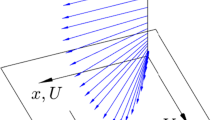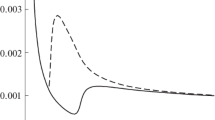Abstract.
The effects of turbulence modeling on the prediction of equilibrium states of turbulent buoyant shear flows were investigated. The velocity field models used include a two-equation closure, a Reynolds-stress closure assuming two different pressure-strain models and three different dissipation rate tensor models. As for the thermal field closure models, two different pressure-scrambling models and nine different temperature variance dissipation rate ɛτ) equations were considered. The emphasis of this paper is focused on the effects of the ɛτ-equation, of the dissipation rate models, of the pressure-strain models and of the pressure-scrambling models on the prediction of the approach to equilibrium turbulence. Equilibrium turbulence is defined by the time rate of change of the scaled Reynolds stress anisotropic tensor and heat flux vector becoming zero. These conditions lead to the equilibrium state parameters, given by \(\tilde{P}/ɛ, \(\tilde{P} τ/ɛτ, \(R \overline{\theta^2}/2 \varepsilon_{\theta}/(k/\varepsilon)\), Sk/ɛ and G/ɛ, becoming constant. Here, \(\tilde{P} and \(\tilde{P} τ are the production of turbulent kinetic energy k and temperature variance \overline{\theta^2}, respectively, ɛ and ɛτ are their respective dissipation rates, R is the mixed time scale ratio, G is the buoyant production of k and S is the mean shear gradient. Calculations show that the ɛτ-equation has a significant effect on the prediction of the approach to equilibrium turbulence. For a particular ɛτ-equation, all velocity closure models considered give an equilibrium state if anisotropic dissipation is accounted for in one form or another in the dissipation rate tensor or in the ɛ-equation. It is further found that the models considered for the pressure-strain tensor and the pressure-scrambling vector have little or no effect on the prediction of the approach to equilibrium turbulence.
Similar content being viewed by others
Author information
Authors and Affiliations
Additional information
Received 21 April 2000 and accepted 21 February 2001
Rights and permissions
About this article
Cite this article
Zhao, C., So, R. & Gatski, T. Turbulence Modeling Effects on the Prediction of Equilibrium States of Buoyant Shear Flows. Theoret Comput Fluid Dynamics 14, 399–422 (2001). https://doi.org/10.1007/s001620100036
Issue Date:
DOI: https://doi.org/10.1007/s001620100036




